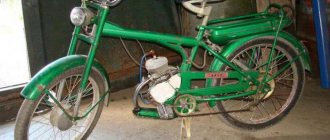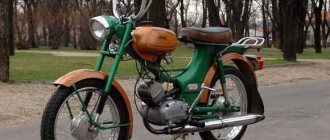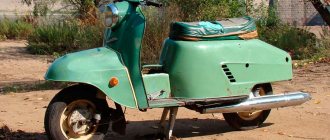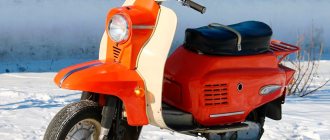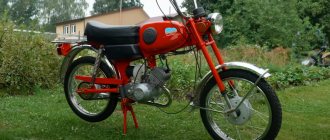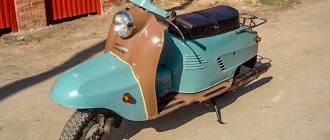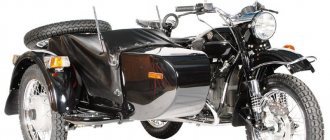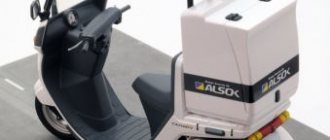Sarkana Zvaigzne, known in Soviet times, is a Riga motorcycle plant specializing in the production of light mopeds. At that time they were one of the best representatives in their category. The eleventh model replaced the seventh series. The only change was the placement of the fuel tank at the rear on top of the frame, which made it easier to ride downhill. As a power unit, the equipment was equipped with a two-stroke engine with a power of 1.2 horsepower and a volume of forty-five and a half cubic centimeters. When the device reached speeds of up to fifty kilometers per hour.
"Riga-11": technical characteristics
- weight is 45 kilograms with a maximum possible load of 100 kg;
- length/width/height - 1.97/0.75/1.15 meters;
- wheelbase - 1,200 millimeters;
- the design speed limit is forty kilometers per hour;
- front suspension - telescopic fork with spring shock absorbers;
- a similar rear element is of a rigid type;
- brake unit - drum type with individual drive for each wheel;
- type of frame - spinal welded structure.
"Riga-11" is a moped that was produced with tires measuring 2.25 by 19 inches.
Mopeds for the Land of the Soviets: “Red Star” of Riga, which was extinguished by nationalists
One of the largest Soviet-era enterprises in Latvia is Riga Moto (“Red Star”). Its foundation is traditionally associated with the period of industrialization of Latvia in the 1960s, when Soviet-made flagships were built one after another in large Baltic cities. Unlike enterprises with a rich pre-revolutionary history, such as VEF or Riga Carriage Works, it was created a little later in interwar Latvia on the basis of a bicycle manufacturing company.
Before talking about the plant, it is worth introducing the reader to Gustav Ehrenpreis. Back in 1907, this young man was accepted into a factory producing bicycles, a fashionable and easy-to-use vehicle. The company was small and specialized mainly in the sale of Triumh and Douglas motorcycles, and also produced its own Baltija bicycles.
The young man was able to quickly gain the trust of the owner, prepared several innovative solutions, and as a result, before the First World War, he took the position of head of the bicycle production department.
The war began, and the enterprise was evacuated to Kharkov - Gustav also went there. After the end of hostilities, engineers and workers returned to Latvia and found no equipment - everything was taken to an unknown direction.
Gustav Erenpreiss / Photo: erenpreiss.com
In 1921, Gustav Ehrenpreis came up with the idea of creating his own motor-building enterprise. At first it was hard, and no one helped with subsidies. But soon a field for experiment arose.
After the Civil War, many cars abandoned by the army of military leader Bermondt-Avalov remained near Riga. Gustav Ehrenpreis discovered them, took them to a workshop, repaired them, and then sold them. In fact, this was the first successful experience of a young engineer-entrepreneur in post-war Latvia.
In 1922, Gustav Ehrenpreis had already opened his small factory on Alexandra Street (now Brivibas Street), where the first bicycles were manufactured.
Thus was born an enterprise that would later become a symbol of the industrial era in the history of Latvia.
Business went uphill, there were more and more buyers. In 1927, the Gustavs Ērenpreiss bicycle factory was officially opened, which produced bicycles of the original design, which became known under the Ērenpreis Original
.
Bicycle factory of Gustav Ehrenpreis / Photo: delphi.lv
By the early 1930s, Ehrenpreis managed to collaborate with bicycle manufacturers Latvelo (within the framework of the Omega association), but decided to operate independently. This is how it appeared on the Baltic market, whose owner was concerned with the issue of building an independent plant.
In 1940, in connection with the proclamation of Soviet power, the enterprise of Gustav Ehrenpreis was nationalized, and during the Nazi occupation, the bicycle manufacturer briefly regained the factory, but in 1944 he left for Germany, reasonably fearing accusations of collaboration.
Advertising posters for the Gustav Ehrenpreis factory
During the Soviet years, the Riga Cycling Center received large-scale government support. Officials who revived the enterprise in the post-war period planned that it would produce 100 thousand bicycles per year. In just 13 years, the company produced 182 thousand bicycles.
By the mid-1950s, priorities had changed slightly. Engineers argued that the production of bicycles was not something out of the ordinary, but in many countries motorized two-wheeled vehicles, which are especially popular among city residents, are becoming increasingly popular.
A historical event took place in 1958: it was then that engineers attached a motor to a bicycle, creating practically the first moped in the history of the USSR, called “Riga-18” (“Riga-1”); simultaneously with the Riga moped, the Kharkov B-901 was released.
In many ways, the creation of this kind of vehicles with engines was influenced by the successful experience of the Czechoslovak “Java”. At the initial stage, the Republic supplied engines to Riga.
Residents of Riga and residents of the entire Soviet Union greeted the innovation with a bang. By the way, the first Riga-18 mopeds, which came out with Java engines, are considered collector's rarities, since the company's management soon decided to use engines produced at the plant in Siauliai.
Later he created engines for Riga mopeds (Leningrad).
Motorcycle "Java"
Soon the company started thinking about creating more modern designs. Thus, in 1961, the production of light mopeds “Gauja” began, which had a rigid frame and a bicycle-type pedal carriage. A Torpedo-type bicycle hub was mounted on the rear wheel. This moped was also equipped with single-speed D4 engines with a volume of 45 cubic centimeters and a power of one horsepower.
In the near future, the fame of the Gauja moped spread everywhere. It consumed relatively little gasoline - 1.5 liters per 100 kilometers at a speed of 20 kilometers per hour.
Light moped Riga-2 Gauja
In the same year, Sarkana Zvaigzne completely abandoned the production of bicycles and switched to the creation of Gauja motorbikes, and then mopeds of various brands: Riga-5 and Riga-7.
If “Riga-18” (“Riga-1”) is considered the first mass-produced two-speed moped in the USSR, then the most modern and popular Soviet moped is undoubtedly “Riga-5”, equipped with a compression spring to dampen the front wheel.
In 1968, the plant produced a modification of this moped with shoe-type brakes, including on the rear wheel. "Riga-5" could take very steep hills and ensured starting from a standstill without the help of pedals.
Moped "Riga-5"
For the development of modern designs “Riga-4” and “Riga-5” and the development of their mass production with an increase in production volumes, a group of plant workers was awarded the State Prize of the Latvian SSR (1970). Meanwhile, the models continued to improve technically.
Back in 1969, Riga-7 rolled off the assembly line, which was soon replaced by Riga-11, which was recognized by the manufacturers as not entirely successful. However, in 1983, the designers of Sarkana Zvaigzne created a lightweight sport-type moped, the Riga-13, which gained wide popularity due to the high-voltage transformer installed on it, through which problems with the ignition coil could be eliminated. This model turned out to be the most popular and was produced until the closure of the legendary Riga plant.
Light moped "Riga-13"
In 1960, 11 mopeds came out of the Sarkana Zvaigzne workshops, in 1961 - 5 thousand, and in 1962 - 27 thousand mopeds of the Riga-1 brand. In 1965, the plant had already produced 90 thousand mopeds of this brand.
In the early 1980s, the plant produced 208.4 thousand mopeds of various types and modifications. The total volume of production in 1983 amounted to 37.9 million rubles.
The growth rate of industrial production and improvement of the technical base were colossal. The brands of Riga mopeds produced at Red Star were recognized in all cities and towns of the USSR.
Soon difficult times came, Latvia announced its secession from the Soviet Union. A general decline in production began in conditions of a severe economic crisis.
The depression also affected, whose production buildings began to fall into disrepair over time. At the same time, the company changed its name, becoming the Riga Motor Plant.
Government structures initially prepared a plan for repurposing the outstanding Soviet plant, since there was a point of view that specialization in a specific product (in this case, mopeds) did not contribute to the successful development of the enterprise in a liberal economy.
Abandoned
As a result, unjustified experiments and a sharp shortage of material resources led to the closure of the plant in 1998. Today, its facades serve for outdoor advertising, including political ones, and often they feature the faces of those people who, through their destructive actions, led to the dismantling of the enormous industrial potential that the Latvian SSR possessed.
Power point
Regarding the engine of this vehicle, the following can be noted:
- two-stroke carburetor engine brand D-6;
- its working volume is forty-five cubic centimeters;
- cooling - air with chamber blowing (crank device);
- cylinder size is 38 millimeters;
- compression ratio - 6, with a piston stroke of 4.4 centimeters;
- The engine produces maximum efficiency at four and a half thousand revolutions per minute.
The Soviet moped is equipped with a single-speed gearbox, a double-disc friction clutch, and reaches a torque of up to 29 Nm. The power unit is started by turning the pedals. The ignition unit is a magnetic system. The exhaust exhaust is released through a muffler with partitions for throttling. With a gear ratio of 4.2, the identical chain drive value is 4.1 (the carburetor used is K-34).
Peculiarities
"Riga-11" is a moped that had certain improvements compared to previous similar models. The spinal frame consists of a central pipe, to which the clamps of the front fork, motor and some other parts are welded. She became tougher and more resilient. The Soviet moped in question was the first modification equipped with a spine-type frame.
The weakest link in the vehicle's design was the wheels. However, compared to the seventh variation, they received an increased cross-section and did not deform so quickly when driving on uneven roads with potholes. The wheel design itself remains unchanged.
The high steering wheel provides a comfortable driving position and is secured using a pair of clamping elements with nuts. This solution allows you to quickly and reliably change its position. The clutch and front brake levers are equipped with ball-shaped tips that protect against injury when falling.
Moped “Riga”05/31/2021
Riga mopeds were very popular in Soviet times; they were produced at the Riga plant. The first moped was “Spiriditis”. But it turned out with many shortcomings. Therefore, plant workers visited the Czech Jawa plant to see how such equipment is produced.
Three years later, the Riga-1 moped appears. To drive such a moped, you must have a license. Because of this, the technique was not very popular.
A little later, the Gauja motorbike was produced. Motor vehicles were equipped with a one-horsepower motor. The frame was folded, weighed a little and was not so reliable. For comfortable operation, the motorbike was equipped with a headlight. The equipment reached speeds of up to 40 km/h.
Two years after the production of Gaul ceased, Riga-3 was released. Outwardly it was very similar to Riga-1. But on the technical side there were slight differences. The new model was equipped with the Sh-51 engine. But he performed poorly. It was unreliable, which is why the demand for equipment from this manufacturer fell sharply.
Another 5 years later, the Riga-4 moped was introduced. It was already equipped with an engine of less than 50 cc. cm and a power of 2 horsepower. Thanks to this, driving licenses are not required to operate the equipment. Because of this, the demand for the model was not bad. Compared to other models, Riga-4 now has a transformer. The moped was also equipped with a new trunk. In addition, smaller 16-inch wheels were used for the first time on this vehicle. Therefore, “Riga-4” was significantly different from other mopeds and attracted people to buy it.
The “Riga-5” moped and the “Gauja” receiver were also produced. The design was significantly different. And the design of the technology had nothing in common. There were no gears and the engine started by turning the pedal. Despite this, Riga-5 was less dynamic and worse than its predecessor.
At the end of the 60s, Riga-7 was released. The new model moped was produced in parallel with the 5th model. True, two years later they stopped producing model 5, since the demand for Riga-7 was greater. It was equipped with an engine to which you can connect a headlight and side lights.
"Riga-7" replaced the moped "Riga-11". It was more interesting and modern. But the engines of these models were identical. But “Riga-11” turned out to be unsuccessful due to its high weight and insufficiently strong frame. And the fuel tank, which was located under the trunk and caused a lot of trouble for the owner. There were especially problems when going uphill, when there was practically no fuel in the tank.
"Riga-12" was produced for 5 years. It had pedals that helped when moving uphill. The model had a filter that was located in the frame. It was produced with different fuel tanks and its mountings. It was similar to the 16 model, but had a completely different seat and a smaller trunk.
The Riga-13 moped turned out better than the 11th model. A 1.3 horsepower engine was installed. Could reach speeds of up to 40 km/h. "Riga-13" is one of the most successful models of the plant. At that time, its advantage was considered to be the presence of good lighting and an installed transformer. Thanks to which it was possible to eliminate ignition problems. The model was mass produced, the last moped “Riga-13” was released in 1998.
"Riga-16" model with two speeds. It had almost the same muffler that was installed on motorcycles and a rear brake lever. Also a rear light, original colors and a new steering wheel. Initially, the model was equipped with the Sh-57 engine, and then the Sh-58. Sh-58 became one of the most successful engines.
In the early 80s, the plant began producing a new model “Riga-22”, which was an improved 16 model. The power unit was very different from the previous ones. The design was good, but the quality let us down. Therefore, the model had to be modernized a little later.
In 1982, the plant introduced the unusual mokik technology “Riga-26”. Over the entire period of production, the mokik has become the manufacturer’s most compact equipment. It could easily be placed on the balcony, in the closet and even in the trunk of a car. Only it was heavy, weighing at least 50 kg. The wheels of model 26 were significantly different from other models and were plump. The seat and steering wheel could be lowered and raised. Therefore, the technology is more compact than others.
In the 90s, the Riga plant tried to produce equipment in small quantities. But this did not lead to anything; in 1988 the plant stopped producing mopeds. Then the plant began to be sold piece by piece. If the plant had produced equipment until today, it would have been able to produce many interesting and popular models. Nowadays scooters and mopeds are very popular.
Device of other nodes
The saddle design has been improved. His box has become more powerful, and the thickness of the pillow has also increased. This solution made it possible to make the driver’s seat more comfortable and increase the usable space for storing tools. The seat spring is fixed with new elements, ensuring the reliability of the entire assembly.
The fuel tank, together with the trunk, is located at the rear of the moped, forming an impressive platform capable of supporting 15-20 kilograms of cargo. is four liters. This reserve is enough for about two hundred kilometers.
Thanks to its solid power reserve, the Riga-11 is a moped that has become popular both among city residents and in rural areas. The engine remains the same, but the chain is made in a new, stronger and more durable version. Due to the wide tires, the engine was shifted to the right of the symmetrical point of the frame by seven millimeters. This made it possible to position the front and rear sprocket in the same plane.
Riga - 7
From the messages that have appeared, motorcyclists already know that Riga has mastered the production of the new light moped “Riga7”. What are its advantages over the previously produced “Riga5”, what distinguishes them? Let's start with the new D6 engine. Although it inherited a number of design features and parts from its predecessor D5, its cylinder and head are now modeled after motorcycles (Fig. 1). Thus, the head is equipped with ribs and is attached to the end of the cylinder using pins (in D5 it was a threaded plug screwed into the cylinder). This improves engine cooling and simplifies its maintenance: to remove carbon deposits from the combustion chamber, you do not need to remove the cylinder. To reduce exhaust noise and better fill the cylinder (due to resonant oscillations of pressure waves), the design of the muffler has been changed. The “electric station” in the new engine has been significantly improved - the magneto now powers not only the ignition system (Fig. 3), but also the A63 lamp (6 V, 3 sv) in the headlight and the A11.5 lamp (! V, 1.5 sv) in the rear light. The magneto (Fig. 4) is located in the same place as on D5, but the cavity in the crankcase for it has become larger. The magneto consists of a rotor crankshaft mounted on a journal! (representing a permanent magnet), induction coil 5, breaker with contacts 9 and !O, capacitor 8. Two windings are wound on the coil core - the primary winding, in which e.g. d.s. low voltage, and a secondary one, where a high voltage current is excited, which is supplied through lead 6 to the spark plug. To make it easier to adjust the ignition timing, marks are marked on the rotor and coil core. When they are combined, the piston does not reach top dead center by 3.2-3.5 mm. Part of the electrical energy generated in the primary coil is discharged through terminal 7 to power the lighting lamps. The advantage of the new engine design is that it can be installed without modifications instead of D4 and D5 engines, and the cylinder with head is also suitable for D5 without modifications. On previous models of light mopeds, a bicycle hub was used in the rear wheel, which braked the wheel when the pedals were pressed in the direction opposite to the movement of the moped. On Riga7, a cast hub (Fig. 5) and a shoe brake are used instead. The front wheel hub is similar to it. These innovations significantly increase the durability of wheels; shoe brakes work more reliably and efficiently. The rear wheel brake is driven by a cable from the pedals. When they rotate in the forward direction (to move the moped forward), the axle rotates along with the sprocket, driving the rear wheel through the chain. If the pedals are rotated backwards, the cam will spread the pads, pressing them against the drum. The front wheel brake is controlled by a lever located at the right handlebar. These are the features and advantages of the new lightweight moped. Technical specifications:
